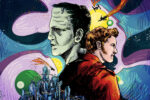“Imaginary Worlds, a show about how we create them and why we suspend our disbelief.” Host Eric Molinsky recites this line at the beginning of every episode of the “Imaginary Worlds” podcast. Each iteration dissects fictional worlds in books, movies, games and any other mediums that excite the fantastical imagination.
The genre of sci-fi is as vast and diverse as the many universes that are created under its banner. Its output makes its way through unfathomable technology, extraterrestrial life, parallel universes and the most far-fetched ideas that the human mind can muster. That possibility, untethered by the confines of our modern technology and knowledge, is exactly what makes this variety of fiction so enticing.
The core of the show goes beyond pure fascination, however, and underlines that the created worlds, no matter how extraordinary, are always made to be believable and are based on relatable human experiences. These two aspects of sci-fi, creating a new universe and creating relatable stories, are essentially one in the same. The “Imaginary Worlds” podcast treats them as such.
It should be obvious that creating fictional worlds is no easy task. The craft takes a wealth of imagination but equally, a healthy amount of restraint. One of the biggest tasks as a sci-fi creator and cultural producer is grounding the fiction in the real world.

The episode “Politics of the Expanse” is quintessential of the podcast’s formula. As the title implies, Molinsky is examining the universe of “The Expanse,” Syfy’s former TV show (now picked up by Amazon Prime) based on the novel series of the same name. The analysis conveys the beginnings of the series, with voice excerpts from the authors as well as the show itself.
After establishing its conception as a book series, Molinsky discusses the discrepancies between the books and the TV series, highlighting the decisions that were made by the producers in adapting the universe of the books for a screen.
As the podcast explains, “The Expanse”‘s universe showcases its many parallels with our contemporary politics. Molinsky makes these apparent through the voices of the authors and producers alike: They frame the factions of Earth, Mars and the Asteroid Belt as analogous to colonial/imperial struggles and showcase the exploitation of resources by large corporations as comparable to large businesses today. The podcast also highlights character arcs that take on these issues, appealing to the traits and ideas that are needed to overcome them.
Even if one has never seen the show or read the books, Molinsky does a great job of selling it. His extensive exposition provides a great basis on which to start and understand the series’ origins and its theme. Near the end of the podcast, Molinsky summarizes “The Expanse” by posing the question: “How powerful is tribalism?” This resonates with my own research on a personal level, but the podcast ends on a very relatable note of how humanity might move forward through all our modern struggles.
Aside from making its way through the narrative and mythologies of sci-fi, the podcast also makes its way through the technical elements that go into it as a craft. Melinsky has produced plenty of episodes that explore the various mediums that bring sci-fi worlds to life.

“Stuck in the Uncanny Valley” is an episode dedicated to the phenomenon of the same name, one produced when humanoid objects cause uneasiness in their observers because of inconsistencies with real life. This issue has been plaguing animators for decades, and Melinsky explores the struggle to overcome the uncanny valley, beginning first with how it is taught to those being trained in the industry today.
He talks to Terrence Masson, Chair of Computer Art design at the School of Visual Arts in New York, and he explains the basic problems that come with trying to imitate human movement and expression. The host elaborates on these issues as they apply to video game animation, in which the humanoid creation has the capacity to be viewed from any direction, placing more pressure on the animators to create realistic movement.
The work that Molinsky is doing in this episode is typical of the “Imaginary Worlds” podcast. He talks with aficionados who can provide insights into the field, theme or specific material that is being covered. Through these conversations and his own analyses, Melinsky teaches the audience about the sci-fi craft and the work that goes into it.
“Living in Space” is one of my favorite episodes from this podcast, as the second half consists of an original theatre skit that Molinsky was himself a part of. The title aptly describes the content covered, discussing the history of the human desire to live in space both in science and science fiction. The host starts with the history of the latter first, describing O’Neill cylinders (huge cylindrical space stations) and then analyzes their sci-fi interpretations, and moving on to their feasibility in the near future.
The second half of the episode, however, features an event called Emerge out of Arizona State University in Tempe which was themed on moon colonies. Molinsky plays himself in the year 2175 and is moderating a discussion between two residents of Luna city, the main colony on the moon in the proposed timeline, on the topic of whether its citizens should branch out to other colonies.
This discussion, as outlandish as the setting might be, is enjoyably convincing and surprisingly relatable. The two residents have a heated debate arguing between security and prosperity against the human capacity to thrive through exploration and innovation. Their fictional discourse is a futuristic microcosm of the timeless struggle between conservative and progressive values.

This last example rounds off the last aspect of Imaginary Worlds, showcasing how the fictional narratives and worlds of the genre are always relatable to our everyday experience. The fresh perspectives on conflicts we already know help us understand issues intrinsic to human nature. And because of their fantastical settings, they often have the capacity to propose solutions that modern times might consider inconceivable.
“Imaginary Worlds” covers a variety of fan-favorite series: “Doctor Who,” “Star Wars,” comic book heroes and other fictional worlds, notably a great episode about “Avatar: The Last Airbender.” Through each entry, the podcast explores the craft, the mythology and the human appeal of the sci-fi genre and beyond. Molinsky does a great job of making each episode intriguing for sci-fi enthusiasts and casuals alike, and deserves to be on your listening feed.

















